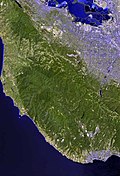San Bruno Creek
San Bruno Creek (Spanish for: "St. Brun") is an intermittent stream that rises on the eastern slopes of the Northern
A hiking trail winds along San Bruno Creek representing an important link in the San Francisco Bay Trail; in fact, this link is needed to make up for lack of access along a large bay front area occupied exclusively by San Francisco International Airport; thus, the Bay Trail must detour a full two miles (3 km) inland from the bay to meet the San Bruno Creek Trail.[3]
History
With the establishment of the
One of the earliest maps showing San Bruno Creek appeared in 1893, prepared by
Above the intersection of Interstate 280 and Interstate 380, the creek runs through Crestmoor Canyon and the Crestmoor residential neighborhood, which was the site of the 2010 San Bruno gas pipeline explosion and fire.
Upper reach
The upper one and a half miles (2,400 m) of San Bruno Creek is the most rugged and natural reach as the stream winds through steep canyons of about 45 degrees in slope. The underlying geological formation of this upper catchment basin is Pleistocene Colma Formation, which continues eastward in the basin under most of the San Francisco Bay Flood Plain. Principal flows of the creek are within the winter months of November to March, the only season of meaningful rainfall in the Bay Area.
See also
References
- U.S. Geological Survey, Montara Mountain Quadrangle, 7.5 Minute Series, U.S. Government Printing Office, Washington, D.C.
- ^ Topographic Maps of the San Bruno Creek Watershed: 1896 and 1939
- ^ San Francisco Bay Trail in the vicinity of Point San Bruno
- ^ City of San Bruno, California Official Site Archived 2007-01-28 at the Wayback Machine
- ^ History of the naming of San Andreas Fault and Lake

